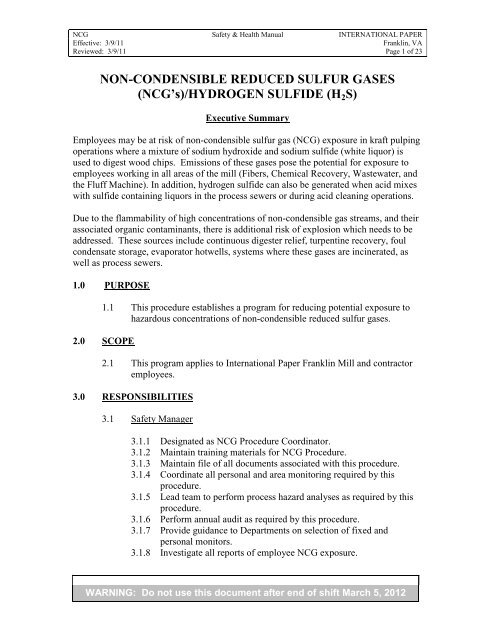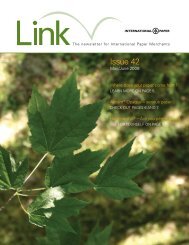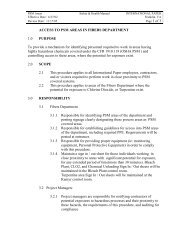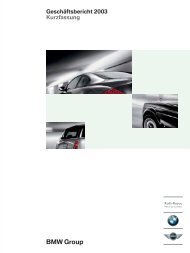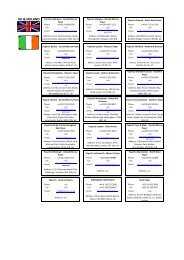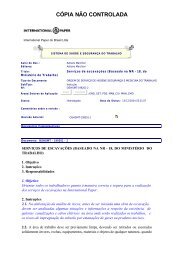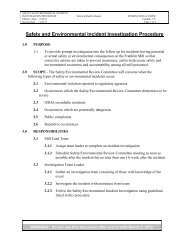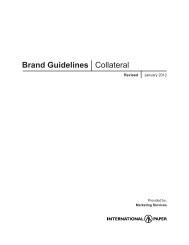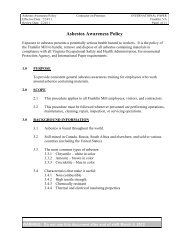(NCG's)/HYDROGEN SULFIDE (H2S) - International Paper
(NCG's)/HYDROGEN SULFIDE (H2S) - International Paper
(NCG's)/HYDROGEN SULFIDE (H2S) - International Paper
Create successful ePaper yourself
Turn your PDF publications into a flip-book with our unique Google optimized e-Paper software.
NCG Safety & Health Manual INTERNATIONAL PAPER<br />
Effective: 3/9/11 Franklin, VA<br />
Reviewed: 3/9/11 Page 1 of 23<br />
NON-CONDENSIBLE REDUCED SULFUR GASES<br />
(NCG’s)/<strong>HYDROGEN</strong> <strong>SULFIDE</strong> (<strong>H2S</strong>)<br />
Executive Summary<br />
Employees may be at risk of non-condensible sulfur gas (NCG) exposure in kraft pulping<br />
operations where a mixture of sodium hydroxide and sodium sulfide (white liquor) is<br />
used to digest wood chips. Emissions of these gases pose the potential for exposure to<br />
employees working in all areas of the mill (Fibers, Chemical Recovery, Wastewater, and<br />
the Fluff Machine). In addition, hydrogen sulfide can also be generated when acid mixes<br />
with sulfide containing liquors in the process sewers or during acid cleaning operations.<br />
Due to the flammability of high concentrations of non-condensible gas streams, and their<br />
associated organic contaminants, there is additional risk of explosion which needs to be<br />
addressed. These sources include continuous digester relief, turpentine recovery, foul<br />
condensate storage, evaporator hotwells, systems where these gases are incinerated, as<br />
well as process sewers.<br />
1.0 PURPOSE<br />
1.1 This procedure establishes a program for reducing potential exposure to<br />
hazardous concentrations of non-condensible reduced sulfur gases.<br />
2.0 SCOPE<br />
2.1 This program applies to <strong>International</strong> <strong>Paper</strong> Franklin Mill and contractor<br />
employees.<br />
3.0 RESPONSIBILITIES<br />
3.1 Safety Manager<br />
3.1.1 Designated as NCG Procedure Coordinator.<br />
3.1.2 Maintain training materials for NCG Procedure.<br />
3.1.3 Maintain file of all documents associated with this procedure.<br />
3.1.4 Coordinate all personal and area monitoring required by this<br />
procedure.<br />
3.1.5 Lead team to perform process hazard analyses as required by this<br />
procedure.<br />
3.1.6 Perform annual audit as required by this procedure.<br />
3.1.7 Provide guidance to Departments on selection of fixed and<br />
personal monitors.<br />
3.1.8 Investigate all reports of employee NCG exposure.<br />
WARNING: Do not use this document after end of shift March 5, 2012
NCG Safety & Health Manual INTERNATIONAL PAPER<br />
Effective: 3/9/11 Franklin, VA<br />
Reviewed: 3/9/11 Page 2 of 23<br />
3.2 Medical Department<br />
3.2.1 Maintain personal exposure data in employee medical files for 30<br />
years.<br />
3.2.2 Inform safety manager of any medical reports of NCG exposure.<br />
3.3 Environmental Engineering<br />
3.3.1 Designate employee to serve on NCG survey team.<br />
3.3.2 Investigate and document all community NCG odor complaints.<br />
3.4 Department Management<br />
3.4.1 Ensure employees are trained in accordance with this procedure.<br />
3.4.2 Ensure equipment is maintained to reduce potential for NCG<br />
exposures.<br />
3.4.3 Maintain and update all applicable operating procedures as needed.<br />
3.4.4 Fibers and Power & Recovery will coordinate Management of<br />
Change (MOC) for NCG processes within their respective<br />
departments.<br />
3.4.5 Fibers, Power and Recovery, and Maintenance may designate<br />
employees to serve on the NCG survey team as needs dictate.<br />
3.5 Employees<br />
4.0 DEFINITIONS<br />
3.5.1 Cooperate and provide needed information for NCG survey as<br />
required by this procedure.<br />
3.5.2 Attend training as required by this procedure.<br />
3.5.3 Follow the provisions of applicable operating procedures.<br />
4.1 Non Condensible Sulfur Gases (NCGs): NCG’s are toxic, corrosive, and<br />
flammable by-product gases of the Kraft pulping process. They consist of<br />
a mixture of hydrogen sulfide, methyl mercaptan, dimethyl sulfide,<br />
dimethyl disulfide. NCG’s are also contaminated with organics such as<br />
WARNING: Do not use this document after end of shift March 5, 2012
NCG Safety & Health Manual INTERNATIONAL PAPER<br />
Effective: 3/9/11 Franklin, VA<br />
Reviewed: 3/9/11 Page 3 of 23<br />
turpentine, methanol, and acetone and therefore pose a risk of fire and<br />
explosion.<br />
4.2 Immediately Dangerous to Life and Health (IDLH): The maximum<br />
concentration from which one could escape within 30 minutes without a<br />
respirator and without experiencing any escape impairing or irreversible<br />
health effects. The IDLH for NCGs are listed below:<br />
4.2.1 Hydrogen sulfide: 100 ppm<br />
4.2.2 Methyl Mercaptan: 150 ppm<br />
4.2.3 Dimethyl Sulfide and Dimethyl Sulfide: Not Established<br />
4.3 Occupational Exposure Limits (OEL): The volume of contaminant in<br />
air/volume of total air allowed for a designated time period. Occupational<br />
exposure limits for hydrogen sulfide and methyl mercaptan have been<br />
established by OSHA and ACGIH. <strong>International</strong> <strong>Paper</strong> has established<br />
internal exposure limits for dimethyl sulfide and dimethyl disulfide as no<br />
regulatory or consensus standards have been established. The<br />
occupational exposure limits are as follows:<br />
4.3.1 Hydrogen sulfide<br />
4.3.1.1 OSHA Ceiling, 20 ppm<br />
4.3.1.2 ACGIH 8-hour Time Weighted Average, 10 ppm<br />
4.3.1.3 ACGIH 15 minute Short Term Exposure Limit, 15 ppm<br />
4.3.2 Methyl Mercaptan<br />
4.3.2.1 OSHA Ceiling, 10 ppm<br />
4.3.2.2 ACGIH 8-hour TWA, 0.5 ppm (based on odor)<br />
4.3.3 Dimethyl Sulfide<br />
4.3.3.1 ACGIH 8-hour Time Weighted Average, 10 ppm<br />
4.3.4 Dimethyl Disulfide<br />
4.3.4.1 ACGIH 8-hour Time Weighted Average, 0.5 ppm<br />
4.4 Management of change (MOC): are written procedures to manage and<br />
review all changes made to process chemicals, technology, personnel,<br />
equipment, and procedures (except for replacement in kind) that could<br />
affect the safety of the process. The responsibilities for these procedures<br />
rest with the affected operating departments.<br />
WARNING: Do not use this document after end of shift March 5, 2012
NCG Safety & Health Manual INTERNATIONAL PAPER<br />
Effective: 3/9/11 Franklin, VA<br />
Reviewed: 3/9/11 Page 4 of 23<br />
4.5 Area Monitors: Fixed, continuous, multi-sensor monitoring systems for<br />
hydrogen sulfide are located in designated areas. Operators in the<br />
appropriate control rooms will be responsible for monitoring these<br />
instruments.<br />
4.6 Personal Exposure monitoring: A method of measuring an individual’s<br />
exposure to a hazardous air contaminant. Personal exposures monitoring<br />
collects the air containment at the breathing zone of an employee, and<br />
therefore represents the truest measure of an employee’s exposure, during<br />
the timeframe in which it was collected.<br />
4.7 Personal Monitor: An <strong>H2S</strong> monitor worn by an individual working in an<br />
area which will give an alarm if air levels reach unacceptable amounts of<br />
<strong>H2S</strong>.<br />
4.8 Process Hazard analysis (PHA): A thorough, orderly, systematic approach<br />
or method of identifying, evaluating, and controlling the hazards of<br />
processes involving hazardous chemicals.<br />
4.9 American Conference of Governmental Industrial Hygienists (ACGIH):<br />
Consensus group that researches occupational health hazards and<br />
establishes exposure recommendations.<br />
4.10 Designated NCG Areas: Mill area or condition where high levels of<br />
NCG’s may exist under the right conditions.<br />
5.0 REFERENCES<br />
5.1 <strong>International</strong> <strong>Paper</strong> Health and Safety Program Guideline HSPG-04.<br />
5.2 Occupational Safety and Health Administration Regulations, 29 CFR<br />
1910.1000.<br />
5.3 American Conference of Industrial Hygienists TLVs.<br />
5.4 Franklin Mill’s Opening Dangerous Systems Procedure<br />
5.5 Franklin Mill’s Hot Work Procedure.<br />
5.6 Franklin Mill’s Respiratory Protection Procedure.<br />
5.7 Franklin Mill’s Emergency Response Procedure.<br />
5.8 <strong>International</strong> <strong>Paper</strong> Technology Non-Condensible Reduced Sulfur Gas<br />
System Design Guidelines.<br />
WARNING: Do not use this document after end of shift March 5, 2012
NCG Safety & Health Manual INTERNATIONAL PAPER<br />
Effective: 3/9/11 Franklin, VA<br />
Reviewed: 3/9/11 Page 5 of 23<br />
6.0 PROCEDURE<br />
6.1 NCG Review and Audit<br />
6.1.1 An analysis to identify where actual and potential NCG hazards<br />
exist and to assess the need for equipment repair, engineering<br />
controls, or administrative controls to minimize NCG hazards will<br />
be conducted. This analysis will be documented using the<br />
checklist in Appendix A.<br />
6.1.2 The analysis will be conducted by a team formed by members<br />
from various departments. Safety, Fibers, Power and Recovery,<br />
Environmental Engineering and Maintenance employees will be<br />
considered (although all are not required) for this team.<br />
6.1.3 The analysis will be updated when new NCG systems are installed<br />
and when process conditions change on existing NCG systems.<br />
6.1.4 The analysis will be revalidated at least every five years.<br />
6.2 Periodic Facility Review<br />
6.2.1 An annual leak detection and repair audit will be performed by<br />
Environmental Engineering.<br />
6.2.1.1 If a leak is detected, repairs must be started within five<br />
days and completed by 15 days.<br />
6.2.1.2 Deviations from the required repair schedule must be<br />
reported to DEQ.<br />
6.2.2 Operating departments must perform a visual inspection of the<br />
NCG generation, collection, and incineration systems on a monthly<br />
basis to ensure the system is properly maintained and the safety<br />
systems are in-place as designated. These areas include NCG gas<br />
and condensate systems.<br />
6.2.3 A review of the NCG procedure will be conducted annually by the<br />
site Safety Manager to ensure the requirements of the procedure<br />
are followed as well as to identify any necessary changes to the<br />
procedure.<br />
6.2.4 Audit reports and corrective action plans will be maintained for<br />
three years.<br />
WARNING: Do not use this document after end of shift March 5, 2012
NCG Safety & Health Manual INTERNATIONAL PAPER<br />
Effective: 3/9/11 Franklin, VA<br />
Reviewed: 3/9/11 Page 6 of 23<br />
6.3 Exposure Assessments<br />
6.3.1 Personal Exposure monitoring will be performed at least once<br />
every 5 years.<br />
6.3.2 Area monitoring using OSHA accepted methods will be used to<br />
perform an initial assessment.<br />
6.3.3 In addition, personal exposure monitoring using OSHA accepted<br />
methods will be performed when initial assessment shows<br />
exposures at or near the occupational exposure limit.<br />
6.4 Dispersion Modeling<br />
6.4.1 Dispersion modeling of potential NCG release points may be<br />
conducted and documented.<br />
6.4.2 Dispersion modeling data may be updated whenever new systems<br />
or process changes are implemented that affect potential NCG<br />
releases.<br />
6.5 Control of Exposure<br />
6.5.1 Engineering Controls<br />
6.5.1.1 Engineering controls will be the primary means of<br />
controlling NCG hazards and exposures.<br />
6.5.1.2 Basic types of engineering controls are listed below:<br />
6.5.1.2.1 Diking acid tanks/container storage.<br />
6.5.1.2.2 Separating acid and sulfide sewers.<br />
6.5.1.2.3 Process changes (e.g., neutralization of<br />
chlorine dioxide salt cake and sewered acid)<br />
6.5.1.2.4 NCG collection and incineration.<br />
6.5.1.2.5 Venting sludge press and belt filters.<br />
6.5.1.2.6 Adjusting NCG vent heights based on<br />
dispersion modeling of NCG releases.<br />
6.5.1.3 All new or upgraded NCG systems should conform to the<br />
latest version of the <strong>International</strong> <strong>Paper</strong> Technology Non-<br />
Condensable Reduced Sulfur Gas System Design<br />
Guidelines.<br />
WARNING: Do not use this document after end of shift March 5, 2012
NCG Safety & Health Manual INTERNATIONAL PAPER<br />
Effective: 3/9/11 Franklin, VA<br />
Reviewed: 3/9/11 Page 7 of 23<br />
6.5.1.4 A Process Hazard analysis (PHA) of all new or modified<br />
NCG collection and incineration systems will be<br />
performed. In addition, a PHA will be completed when<br />
process conditions change that could significantly affect<br />
NCG hazards/exposures.<br />
6.5.1.5 PHA’s will be revalidated every 5 years.<br />
6.5.1.6 Persons knowledgeable in the process and in PHA<br />
methods and techniques will conduct the PHA.<br />
6.5.1.7 Changes to the NCG system will be tracked through a<br />
formal Management of Change (MOC) process.<br />
6.5.2 Administrative Controls<br />
6.5.2.1 Administrative Controls will be used as the secondary<br />
means of control.<br />
6.5.2.2 Operating procedures will be established for the<br />
following:<br />
6.5.2.2.1 Acid cleaning digesters, liquor heaters,<br />
evaporators, recovery boiler, green liquor lines<br />
and mud filters (or any process where sulfidecontaining<br />
liquids are mixed with acids).<br />
(Note: there are very specific requirements for<br />
acid cleaning procedures.<br />
6.5.2.2.2 Response to NCG vents to the atmosphere.<br />
6.5.2.2.3 NCG line breaking as listed in the Franklin<br />
Mill’s Opening Dangerous Systems Procedure.<br />
6.5.2.2.4 Loading/unloading black liquor soap, brine,<br />
sodium hydrosulfide and turpentine. (Note:<br />
there are very specific requirements for<br />
turpentine)<br />
6.5.2.2.5 pH adjustment in process sewer.<br />
6.5.2.2.6 Handling/processing wastewater treatment<br />
sludge.<br />
6.5.2.2.7 Using and responding to personal and area<br />
monitors.<br />
6.5.2.2.8 Hot work on NCG system as outlined in the<br />
Franklin Mill Hot Work Procedure.<br />
6.5.2.2.9 Cleaning any tank containing fiber residue<br />
(decaying stock is also a source of NCG gas<br />
release).<br />
WARNING: Do not use this document after end of shift March 5, 2012
NCG Safety & Health Manual INTERNATIONAL PAPER<br />
Effective: 3/9/11 Franklin, VA<br />
Reviewed: 3/9/11 Page 8 of 23<br />
6.5.2.3 Area monitors will be placed in areas with high potential<br />
for NCG release. Monitors must be calibrated (with<br />
calibration gas) and maintained per manufacturer’s<br />
instruction (minimum monthly requirement). Alarms will<br />
be set based on most protective OEL (e.g. 8 – hour TWA).<br />
6.5.2.4 Personal monitors will be worn by employees working in<br />
areas where fixed monitors are inoperable. One monitor is<br />
adequate for more than one individual as long as they<br />
remain in reasonably close proximity to each other.<br />
Employees should check to make sure personal meter is<br />
functioning properly in clean atmosphere prior to entering<br />
NCG area. Personal monitors will be calibrated monthly<br />
(minimum) with calibration gas. Calibration will be<br />
performed according to the manufacturer’s guidelines.<br />
6.5.3 Personal Protective Equipment<br />
6.5.3.1 Personal Protective Equipment (PPE) will be used as a<br />
tertiary means of control.<br />
6.5.3.2 All employees working in TRS designated areas will have<br />
an escape respirator in their possession.<br />
6.6 Designated NCG Designated Areas<br />
6.6.1 General Requirements for Working in Area<br />
6.6.1.1 Entrances to the NCG designated areas may be marked by<br />
caution signs. These signs will state "Caution - Designated<br />
TRS area - check in at appropriate control room before<br />
working in the area. An escape respirator must be in your<br />
possession.”<br />
6.6.1.2 NCG Designated Ares include:<br />
(1) Around any NCG rupture disk or atmospheric vent.<br />
(2) E set hotwell.<br />
(3) Any NCG equipment where maintenance or<br />
troubleshooting is being performed.<br />
(4) Turpentine decanter and storage tank dike<br />
(5) Turpentine Storage and Loading Facility<br />
(6) Acid and process sewer mixing (pH control station)<br />
(7) LK burner Deck<br />
(8) RTO<br />
(9) Sludge building and clarifiers<br />
(10) Landfill leachate area<br />
WARNING: Do not use this document after end of shift March 5, 2012
NCG Safety & Health Manual INTERNATIONAL PAPER<br />
Effective: 3/9/11 Franklin, VA<br />
Reviewed: 3/9/11 Page 9 of 23<br />
6.6.1.3 Employees who are not assigned daily to the area must<br />
check in with the appropriate control room. Ask about any<br />
TRS concentrations in the area and inform the control room<br />
operators regarding the location and duration of the job<br />
task.<br />
6.6.1.4 When the fixed, continuous monitor sensors and/or the<br />
sensor audio/visual alarms are inoperable or unreliable,<br />
employees entering the area will be required to use a<br />
personal hydrogen sulfide monitor. One monitor is<br />
adequate for more than one individual as long as they<br />
remain in reasonably close proximity to each other. These<br />
monitors must be approved for use by the Safety<br />
Department and properly calibrated.<br />
6.6.1.5 Employees must have in their possession a minimum of a<br />
North 7902 organic vapor/acid gas escape respirator.<br />
6.6.1.6 Employees entering and working in the designated area are<br />
responsible for informing control room operators and/or<br />
their supervisor of any unusual concentrations of TRS<br />
gases noted while in the area. These employees will<br />
evacuate the TRS area if TRS concentrations are known or<br />
suspected to be hazardous, and whenever the audio/visual<br />
alarms are activated.<br />
6.6.1.7 Upon knowledge of a condition or process upset which has<br />
or might potentially result in the emission of hazardous<br />
concentrations of TRS gas, the control room operator will<br />
initiate notification of those individuals in the TRS area<br />
who might be exposed to these concentrations. Log book<br />
entries will be made accordingly.<br />
6.7 Respiratory Protective Equipment<br />
6.7.1 Respiratory protection will be used in accordance with the Franklin<br />
Mill’s Respiratory Protection Procedure.<br />
6.7.2 Only supplied air respirators may be used to work in known or<br />
unknown concentrations of NCG.<br />
6.7.3 Air purifying respirators, such as the North 7902 escape respirator,<br />
are approved for escape only.<br />
WARNING: Do not use this document after end of shift March 5, 2012
NCG Safety & Health Manual INTERNATIONAL PAPER<br />
Effective: 3/9/11 Franklin, VA<br />
Reviewed: 3/9/11 Page 10 of 23<br />
6.8 Emergency Procedures<br />
6.8.1 Emergency Procedures are outlined in the Franklin Mill’s<br />
Emergency Response Plan.<br />
6.9 Notification of Exposure<br />
7.0 TRAINING<br />
6.9.1 Employees who experience adverse health effects from exposure to<br />
NCG must report to Medical as required in the Franklin Mill’s<br />
Incident and Injury Reporting Procedure.<br />
6.9.2 Medical will notify the Safety Manager of all reported NCG<br />
exposures.<br />
6.9.3 The Safety Manager will report any significant (explosion,<br />
hospitalization, etc.), unusual or unexpected sources of exposure<br />
per Corporate requirement.<br />
6.9.4 The Safety Manager will investigate all reported NCG exposures<br />
and will perform monitoring as necessary to assess exposure.<br />
7.1 All employees working in or around NCG hazards will be trained before<br />
assignment and annually on the NCG Procedure.<br />
7.2 Training will include the following:<br />
7.2.1 Recognition of NCG hazards.<br />
7.2.2 Applicable operating procedures.<br />
7.2.3 Health hazards of NCG’s.<br />
7.2.4 Fire/Explosion hazards of NCG’s.<br />
7.2.5 Appropriate emergency and evacuation procedures.<br />
7.2.6 Summary of any monitoring conducted in applicable area.<br />
7.2.7 Use of personal monitoring equipment.<br />
7.2.8 Use of emergency respiratory equipment.<br />
8.0 DOCUMENTATION<br />
8.1 The NCG Survey (Appendix A) will be updated at least every five years<br />
and when process changes occur. The NCG Survey will be retained until<br />
superceded.<br />
8.2 Documentation related to the annual audits of the NCG procedure will be<br />
retained for three years.<br />
WARNING: Do not use this document after end of shift March 5, 2012
NCG Safety & Health Manual INTERNATIONAL PAPER<br />
Effective: 3/9/11 Franklin, VA<br />
Reviewed: 3/9/11 Page 11 of 23<br />
8.3 Employee training records will be retained until superseded.<br />
8.4 Calibration and maintenance data for area monitors will be retained for<br />
three years (via the work order system).<br />
8.5 Calibration and maintenance data for personal monitors will be retained<br />
for three years (currently at S:\Data\Projects\Mill Closure\Safety Notes<br />
and Inspections\ biosystems calibration log “Year” .xlsx).<br />
8.6 PHA documentation will be kept for the life of the process.<br />
8.7 Applicable NCG operating instructions will be retained until superceded.<br />
8.8 Personal exposure monitoring data will be retained in the affected<br />
employee’s Medical file for at least 30 years.<br />
8.9 Area monitoring data will be retained in the Industrial Hygiene files for 30<br />
years.<br />
9.0 APPROVAL AND ISSUE<br />
This procedure is approved by the Franklin Lead Team.<br />
10.0 REVISION HISTORY<br />
DATE MODIFICATIONS<br />
Mar 1, 2011 New<br />
WARNING: Do not use this document after end of shift March 5, 2012
NCG Safety & Health Manual INTERNATIONAL PAPER<br />
Effective: 3/9/11 Franklin, VA<br />
Reviewed: 3/9/11 Page 12 of 23<br />
ATTACHMENT A<br />
NCG/<strong>H2S</strong> SURVEY CHECKLIST<br />
WARNING: Do not use this document after end of shift March 5, 2012
NCG Safety & Health Manual INTERNATIONAL PAPER<br />
Effective: 3/9/11 Franklin, VA<br />
Reviewed: 3/9/11 Page 13 of 23<br />
I. SEWERS AND WASTEWATER TREATMENT<br />
A. P & ID Review<br />
___ Identify location of sample points where NCGs are likely to evolve (e.g. parshall<br />
flumes and foam boxes).<br />
___ If possible, obtain sample results for pH and flows at each sample point for the<br />
past 30 days (e.g., pH levels less than 9.5 found in sewers which contain sulfides<br />
(such as spent liquors) have the potential to generate <strong>H2S</strong> gas).<br />
___ Identify locations where sulfides and acids may mix in sewers or clarifiers.<br />
___ Determine if any vents are installed on closed sewers. If vents are installed,<br />
determine vent height from ground and concentration and flow of NCGs from<br />
ent.<br />
___ Determine if acid and sulfide sewers mix at waste treatment.<br />
___ Determine where acid is added for pH control.<br />
B. Interview Lab Sample Takers and Wastewater Treatment Operators<br />
___ Question sample taker and wastewater treatment operators on potential NCG<br />
areas.<br />
___ Question sample taker on any swings in pH of sewers.<br />
C. Survey Sewers<br />
___ Note location and condition of area monitors that are positioned to monitor<br />
sewers.<br />
___ Monitor in areas where sulfide and acid sewers combine.<br />
___ Monitor open foam boxes and parshall flumes.<br />
___ Monitor sewer vents, if reachable.<br />
___ Determine height of sewer vents relative to surrounding work areas.<br />
D. Survey Wastewater Treatment<br />
___ Monitor where sewer exits closed sewer and enters waste treatment.<br />
WARNING: Do not use this document after end of shift March 5, 2012
NCG Safety & Health Manual INTERNATIONAL PAPER<br />
Effective: 3/9/11 Franklin, VA<br />
Reviewed: 3/9/11 Page 14 of 23<br />
___ Monitor where sewer streams combine before clarifying (if applicable).<br />
___ Monitor at splitter box (if applicable).<br />
___ Determine if the acid storage tank used for pH adjustment is diked to contain the<br />
contents of the tank or routed to a non-sulfide source.<br />
___ Monitor while acid is added for pH control.<br />
___ Monitor top or vent of sludge mix tank (if reachable).<br />
___ Monitor sludge presses and other sludge processing equipment.<br />
___ Monitor effluent of sludge processing equipment.<br />
___ Determine if leachate is collected from the landfill. Request to be taken to the<br />
collection location to monitor (if applicable).<br />
II. NCG SYSTEM AND THE LIME KILN<br />
A. P & ID Review<br />
1. NCGS<br />
___ Identify all NCG sources for each type of stream.<br />
___ Identify the location of all rupture disks.<br />
___ Identify all NCG vents.<br />
___ Determine vent height, NCG concentration, and flow.<br />
___ Identify the location of all NCG eductors.<br />
___ Inquire if any modifications have made to the original installation.<br />
___ Determine NCG scrubbing media, if applicable.<br />
___ Determine disposal of NCG scrubbing media.<br />
___ Identify primary and alternate NCG disposal systems (i.e., incinerator,<br />
lime kiln, boiler, atmospheric vent).<br />
WARNING: Do not use this document after end of shift March 5, 2012
NCG Safety & Health Manual INTERNATIONAL PAPER<br />
Effective: 3/9/11 Franklin, VA<br />
Reviewed: 3/9/11 Page 15 of 23<br />
___ Determine routing of condensate to sewer.<br />
___ Identify location of NCG seal pots for condensate.<br />
___ Identify location of flame arrestors.<br />
2. Recausticizing<br />
B. Survey NCGs<br />
___ Locate acid storage in area for mud filter washing.<br />
___ Note location and condition of area monitors (e.g., <strong>H2S</strong> monitors) positioned to<br />
monitor the NCGS.<br />
___ Locate all rupture disks and evaluate locations.<br />
___ Locate all NCG vents and evaluate locations and heights relative to surrounding<br />
work areas.<br />
___ Locate flame arrestors and assure each has blank flanges or valving so line can<br />
be isolated while performing maintenance on flame arrestor.<br />
___ Assure each flame arrestor has taps on each side for pressure measurement to<br />
test for pluggage.<br />
C. Interview Lime Kiln Operator<br />
___ Question the operator on potential NCG areas.<br />
___ Determine how an operator knows when a rupture disk is blown.<br />
___ Question the operator on the response that is made when a disk is blown.<br />
___ Determine how often a rupture disk is blown.<br />
___ Determine how often NCG is vented at the kiln and at the source.<br />
___ Determine if green liquor lines are acid cleaned. What precautions are taken?<br />
___ Question the operator about <strong>H2S</strong> coming off the vent of the sodium hydrosulfide<br />
(NaHS) (or NaSH) storage tank while filling. Determine what precautions are<br />
taken while filling.<br />
WARNING: Do not use this document after end of shift March 5, 2012
NCG Safety & Health Manual INTERNATIONAL PAPER<br />
Effective: 3/9/11 Franklin, VA<br />
Reviewed: 3/9/11 Page 16 of 23<br />
___ Question operator about <strong>H2S</strong> exposure during mud filter acid cleaning.<br />
___ Question the operator on location of area monitors in limekiln area (if<br />
applicable).<br />
D. Survey Lime Kiln<br />
III. PULP MILL<br />
___ Note location and condition of area <strong>H2S</strong> monitor (if applicable).<br />
___ Locate acid storage and determine potential of acid leak combining with a<br />
sulfide source (i.e. diked tanks, remote drum storage).<br />
___ Determine if unlabeled acid lines are routed over sulfide sources.<br />
___ Inspect acid truck unloading pad to assure leaks will not combine with sulfide<br />
sources (if applicable).<br />
___ Locate and monitor where spent white liquor NCG scrubbing liquid is injected<br />
into recausticizing system (if applicable).<br />
A. P & ID Review<br />
___ Determine source of wash water (i.e. combined condensate, stripped condensate,<br />
contaminated hot water).<br />
___ Determine if the chip bin on a continuous digester(s) has a pressure/vacuum<br />
relief.<br />
___ Determine if digester flash steam condensate is sewered or used in process.<br />
___ Identify acid storage/day/cleaning tanks.<br />
___ Review ClO2 generation to determine route of spent acid (if R-2 or R-8) and<br />
dissolving of salt cake (i.e. acidic salt cake dissolved in black liquor).<br />
___ Review turpentine system loading/unloading procedures (if applicable).<br />
___ Ask for a copy of the written acid cleaning procedures.<br />
___ Determine if the mill has installed a system to dissolve ClO2 generator salt cake<br />
in water before mixing with black liquor (if applicable).<br />
WARNING: Do not use this document after end of shift March 5, 2012
NCG Safety & Health Manual INTERNATIONAL PAPER<br />
Effective: 3/9/11 Franklin, VA<br />
Reviewed: 3/9/11 Page 17 of 23<br />
___ Determine if white liquor is used as scrubbing media for the bleach plant<br />
scrubber and the disposal location for the media.<br />
B. Interview Pulp Mill Operator<br />
___ Question the operator on potential NCG areas.<br />
___ Determine how an operator knows when a NCG rupture disk is blown.<br />
___ Question the operator on the response that is taken when a disk is blown.<br />
___ Determine how often a rupture disk is blown.<br />
___ Determine how often NCG vent at the source.<br />
___ Question the operator on what the pulp mill cleans with acid.<br />
___ Determine if the acid from acid cleaning is neutralized before sewering.<br />
___ Question the operator on location of area monitors in pulp mill area (if<br />
applicable).<br />
C. Survey Pulp Mill<br />
___ Determine purpose of all vent stacks and note height.<br />
___ Note location and condition of area <strong>H2S</strong> monitors, if applicable.<br />
Note: Evaporators are covered in the power plant section.<br />
1. Continuous Digesting<br />
___ Determine the source of air for the control room.<br />
___ Monitor top of the chip bin and around the boot.<br />
___ Monitor around knot conveyor if it enters the chip bin.<br />
___ Monitor the steaming vessel.<br />
___ Determine if flash steam condensate goes to a closed or open sewer.<br />
WARNING: Do not use this document after end of shift March 5, 2012
NCG Safety & Health Manual INTERNATIONAL PAPER<br />
Effective: 3/9/11 Franklin, VA<br />
Reviewed: 3/9/11 Page 18 of 23<br />
2. Turpentine System<br />
___ Determine if gases from the turpentine decanter under-flow are vented<br />
and assess the location of the vents.<br />
___ Determine how the underflow is transferred from the decanter. If<br />
transferred to a tank, assure the tank is sealed. If piped to a sewer,<br />
assure the sewer is closed and/or sealed.<br />
___ Locate turpentine condenser and evaluate exposure potential to NCG.<br />
___ Evaluate the turpentine loading system. Is the loading process<br />
monitored using an automatic level detection system or is the level<br />
visually determined. If visually determined, is respiratory protection<br />
(e.g., air-supplied respirator such as an SCBA) used when operator<br />
takes a visual reading? Ensure Procedure 5.3 – Turpentine Loading<br />
and NCG/<strong>H2S</strong> is being followed.<br />
___ Monitor the loading process. Is the IP Loading/unloading procedure<br />
and form used by the operator? The Bulk Chemical loading /unloading<br />
forms (Truck and Rail) can be found located at:<br />
http://ipweb.ipaper.com/usdistribution/Rail/HBC.htm<br />
3. Pulp Washing<br />
___ Locate the contaminated hot water/stripped condensate tank and<br />
determine if the overflow is routed to a closed or surface sewer or if it<br />
is used in washing.<br />
___ Determine if the conductivity of the wash water is monitored to detect<br />
evaporator pull-over or inadequate stripping.<br />
___ Locate the vent to the contaminated hot water, stripped condensate, and<br />
stripper feed tank and evaluate exposure potential.<br />
___ Monitor brown stock washers if contaminated hot water/stripped<br />
condensate is used to wash brown stock.<br />
___ Locate the vent to the brown stock washers and evaluate exposure<br />
potential.<br />
4. Acid Cleaning<br />
___ Determine if the acid storage tanks for acid cleaning of equipment (i.e.,<br />
liquor heaters) is diked to contain contents or routed to an acid sewer.<br />
Locate truck/rail car charging valve to acid storage and assess the<br />
potential of acid mixing with a sulfide source.<br />
WARNING: Do not use this document after end of shift March 5, 2012
NCG Safety & Health Manual INTERNATIONAL PAPER<br />
Effective: 3/9/11 Franklin, VA<br />
Reviewed: 3/9/11 Page 19 of 23<br />
___ Assure acid cleaning tank is diked to contain contents.<br />
___ Assure acid cleaning tank is vented outside of any work area and that<br />
tank is sealed during cleaning.<br />
5. Chlorine Dioxide (CIO2) Generation<br />
In an R-2 process, spent acid is a byproduct. In an SVP/R-3 and R-8 process<br />
acid is recycled in the generator. In all three processes (R-2, SVP/R3, and R-8)<br />
salt cake is a byproduct. The salt cake is usually slurried in water and<br />
neutralized before mixing with weak liquor or strong black liquor. Spent<br />
acid/salt cake from a chlorine dioxide generator should not be mixed directly<br />
with strong black liquor.<br />
___ Determine type of ClO2 generating process (R-2, SVP/R-3, R-8).<br />
___ Determine if the acid storage for the ClO2 generator is diked to contain<br />
contents or routed to an acid sewer if in a sulfide area. Locate truck/rail<br />
car charging valve to acid storage and assess the potential of acid<br />
leaking and mixing with a sulfide source.<br />
___ Determine where spent acid from the ClO2 generator is routed (if<br />
applicable).<br />
___ Trace spent acid line and identify all drain valves that would drain to<br />
sulfide source (if applicable).<br />
___ Assure spent acid line is labeled (if applicable).<br />
___ Assure spent acid tank is diked to contain contents or routed to an acid<br />
sewer (if applicable).<br />
___ Determine if the spent acid tank overflow is routed to a closed acid<br />
sewer (if applicable).<br />
___ Determine if the exhaust on the salt cake filter is pulling a negative<br />
pressure (if salt cake is mixed with liquor).<br />
___ Determine if the salt cake slurry tank/mix tank/dissolving tank is<br />
vented from a work area if salt cake is dissolved directly in black<br />
liquor.<br />
___ Determine if the salt cake slurry tank/mix tank/dissolving tank is diked<br />
to contain contents or routed to an acid sewer if the tank contains black<br />
liquor.<br />
WARNING: Do not use this document after end of shift March 5, 2012
NCG Safety & Health Manual INTERNATIONAL PAPER<br />
Effective: 3/9/11 Franklin, VA<br />
Reviewed: 3/9/11 Page 20 of 23<br />
IV. POWER & RECOVERY<br />
A. P & ID Review<br />
___ Determine the route of the overflow for the salt cake slurry tank/mix<br />
tank/dissolving tank.<br />
1. Evaporators<br />
2. Stripper<br />
___ Identify vents.<br />
___ Determine if evaporators are acid cleaned.<br />
___ Review black liquor soap storage/handling procedures.<br />
___ Determine condensate flows.<br />
___ Identify vents.<br />
B. Interview Evaporator Operator<br />
___ Question the operator on potential <strong>H2S</strong> areas.<br />
___ Determine how an operator knows when a rupture disk is blown.<br />
___ Question the operator on the response when a disk is blown.<br />
___ Determine how often a rupture disk is blown.<br />
___ Determine how often NCGs vent and at what location.<br />
___ Question the operator on location of area monitors in evaporator area (if<br />
applicable).<br />
C. Survey Evaporator Area<br />
___ Determine purpose of all vent stacks and note height.<br />
___ Note location and condition of area <strong>H2S</strong> monitors, if applicable.<br />
WARNING: Do not use this document after end of shift March 5, 2012
NCG Safety & Health Manual INTERNATIONAL PAPER<br />
Effective: 3/9/11 Franklin, VA<br />
Reviewed: 3/9/11 Page 21 of 23<br />
___ Assure legible NCG (or <strong>H2S</strong>) warning signs are posted in potential NCG (or<br />
<strong>H2S</strong>) areas.<br />
1. Evaporators<br />
___ Monitor for leaks around the evaporator hotwells/seal tanks.<br />
___ Assure the hotwell/seal tank overflow goes to a closed sewer. If not,<br />
assure an area monitor is in place and that the water trap on the<br />
overflow is rated at a higher pressure than the NCG rupture disk.<br />
___ Determine if the hotwell/seal tank NCG by-pass vent to atmosphere is<br />
located away from a work area.<br />
___ Assure hotwells/seal tanks are vented to the NCG system.<br />
___ Check manhole covers to hotwell (if applicable) to assure they are<br />
bolted, sealed or locked.<br />
___ Determine if the contaminated/foul condensate lines and tanks are<br />
routed to a closed sewer. Monitor around the tank(s).<br />
2. Condensate Stripper (if applicable)<br />
___ Monitor for leaks around the condensate feed tank, stripper and vent.<br />
3. Weir Box/Blend Tank/Mix Tank<br />
4. Boiler<br />
This list is applicable only if spent acid (usually from CIO2 generator) is added<br />
to the weir box, blend tank or salt cake mix tank.<br />
___ Monitor around the tank.<br />
___ Assure the tank is vented to the NCGs.<br />
___ Assure the NCGs bypass vent to the atmosphere is located away from a<br />
work area.<br />
___ Review acid cleaning procedures for boilers.<br />
WARNING: Do not use this document after end of shift March 5, 2012
NCG Safety & Health Manual INTERNATIONAL PAPER<br />
Effective: 3/9/11 Franklin, VA<br />
Reviewed: 3/9/11 Page 22 of 23<br />
V. PAPER MACHINE<br />
A. Interview Operator<br />
___ Question the operators on potential NCG areas (i.e., NCGs from sewers).<br />
B. Survey <strong>Paper</strong> Machine<br />
___ If potential areas are identified by operators.<br />
VI. WOODYARD/WOOD ROOM<br />
A. Interview Operator<br />
___ Question the operators on potential NCG areas (i.e., NCG from sewers).<br />
B. Survey Woodyard<br />
___ If potential areas are identified by operators.<br />
WARNING: Do not use this document after end of shift March 5, 2012
NCG Safety & Health Manual INTERNATIONAL PAPER<br />
Effective: 3/9/11 Franklin, VA<br />
Reviewed: 3/9/11 Page 23 of 23<br />
NCG SURVEY DATA COLLECTION FORM<br />
Site Location: _______________________ Department/Area: _______________________<br />
Monitoring Equipment: (Mfg.) _______________ (Model) ____________ (Serial #) ___________<br />
Monitor Calibration Date: ______________ Monitoring Performed by: ____________________<br />
Date/Time Sample Location Observations<br />
NCG Level<br />
(as <strong>H2S</strong>)* ppm/mg/m 3<br />
Note: When recording field observations, remember you are looking for potential as well as actual hazards.<br />
Therefore, record information on the potential for acid and sulfide sources to mix, location of NCG vents,<br />
frequency and type of employee work activities in areas. For potential hazard observations, mark the NCG<br />
level (e.g., as <strong>H2S</strong> and/or methyl mercaptan) column as “NA”.<br />
WARNING: Do not use this document after end of shift March 5, 2012


